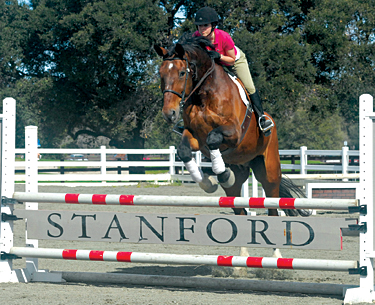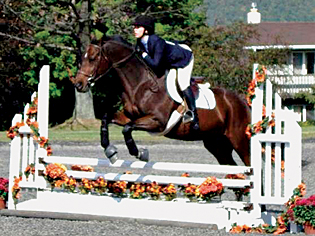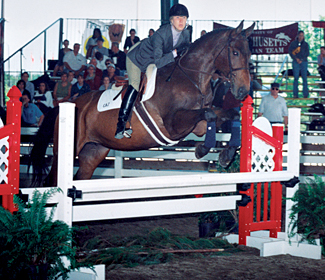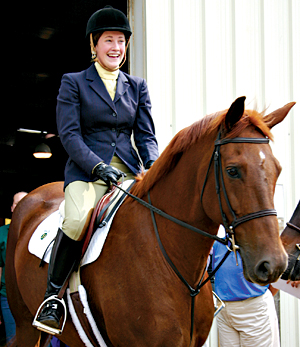These saintly horses are often overlooked, but without them, intercollegiate horse showing wouldn’t be possible.
The Intercollegiate Horse Show Association format makes it easy to leave out the horses. After all, riders seldom show the same horse twice, and their biggest wins often come on horses they’ll never see again.
But the coaches and students know that without the horses, IHSA wouldn’t be possible, and most every team has a special veteran who deserves recognition.
 For Vanessa Bartsch, head coach of the Stanford University Equestrian Team (Calif.), the standout on her team is Bullwinkle, who was donated by the Gans family. Although he’s only been a team member for three years, he’s already made a huge impression.
For Vanessa Bartsch, head coach of the Stanford University Equestrian Team (Calif.), the standout on her team is Bullwinkle, who was donated by the Gans family. Although he’s only been a team member for three years, he’s already made a huge impression.
“When the mother of one of our students called and offered us an 18.3-hand warmblood with stringhalt, sight unseen from the East Coast, I thought she was crazy,” admitted Bartsch. “But it turned out that one of my freshmen, Anders Jones, was going to be at the New England Equitation Finals where this horse was showing.”
Bartsch charged her student to find out more about the overlarge animal. He called her from the show to say that “Mosby” was sweet, but very big.
“I said that we have a lot of big horses here, so I wasn’t worried about that,” Bartsch recalled. “But Anders replied, ‘No, he’s really, really, really big. Like I can’t even see over his withers.’ Now this was something as the student is 6’2″!”
Bartsch agreed to take a chance on the 18-year-old Westphalian on the assurances of her student who claimed he was “a saint.” He arrived in Stanford, Calif., a month later.
“He stepped off of the trailer after a three-day trailer ride, and he was just about the biggest horse I have ever seen,” said Bartsch. “He was walking toward me with the most exaggerated high-step I’ve ever seen in a horse with shivers. The girls on the team who were at the barn said he looked like a dinosaur!”
Although it wasn’t a promising beginning, Mosby soon distinguished himself as an absolute sweetheart, which was good since his head was bigger than many of the students’ torsos.
“It’s like sitting in the treetops from way up there, but Mosby is the perfect schoolmaster,” said Bartsch. “He makes every course look easy, and he’ll easily step up and cover the gap from a long spot, or sit back and make it look like every add was meant to be. I’ve never seen a horse that covers a 14-foot stride just as easily as he collects to a 9-foot step. He has been the first jumping horse for many of our lower level riders, yet he can just as easily get out there and let our open riders practice at height.”
His large barrel requires a 56-inch girth with extenders, and some of the shorter riders need a stepladder to
groom him. He required a custom stall and oversized turnout to accommodate his bulk.
“Mosby’s most distinguishing characteristic is his ‘duck walk.’ With his stringhalt, he has the hugely exaggerated hind-end walk, lifting each hind foot way up and over, before carefully putting it back down,” said Bartsch. “At the trot and canter he’s sound as a bell, and you’d never know.”
Bartsch learned that Mosby had contested grand prix classes in his younger years. “Now he’s one of the elder statesmen of the barn and keeps a steady schedule of lower level lessons,” she said. “He’s just one of those horses that everyone on the team loves to ride. He makes 3′ look like cavaletti!”
The Cornerstone Of The Program
Malinda Grice, coach for the Penn State University Equestrian Team, had a hard time choosing which notable horse to recognize in her program, but after speaking with her riders, she decided that Lenox deserved the honor.
ADVERTISEMENT
The 18-year-old, bay Thoroughbred has spent the past nine years in the Penn State program at David Flynn’s Eastwood Farms in Bellefonte, Pa.

Lenox does double duty, showing and winning in the 2’6″ divisions in the summer and playing school horse all winter.
“He’s the one I put everybody on before they go to Zones and Nationals because they can nail the jumps on him, and he’ll swap his leads every time,” said Grice. “He inspires confidence in the kids.”
Grice was cautious at first with Lenox. She only allowed her best riders aboard. “I wanted to protect him,” she said. “But as he’s aged, I can put him in the lower level lessons to protect him so he doesn’t have to jump every single lesson.”
Occasionally, they’ll take Lenox to regional shows if the host team is scrambling for horses.
“All of the other teams know him,” said Grice. “At our intercollegiate horse shows, they’re thrilled if they draw him. You have to make a mistake to not win on him. He’s the cake draw at every intercollegiate horse show. He’s always the winner to the jumps.”
Lena Ohta, team president, said that everyone on the team loves him. “He definitely is a joy to ride,” she said. “He’s not a pushbutton horse, but he’s a very good horse and a good teacher. You know that if he does anything wrong, it’s because you did it, not because he did it.”
Lenox never gets irritated and loves to cuddle, according to Ohta. “He’s the exact horse that you’d want if you could have a horse,” she said. “There’s always a fight to be his handler at horse shows. We all want to hold him. He’s such a good guy. I had an alumnus e-mail me and offer to hold him at the horse show.”
But the venerable Lenox does have one quirk. “Going out and coming in from the paddock, he’s going to jig and fuss,” said Grice. “Once you turn him out, he drops his head and eats grass. You have to put a chain on him to take him out. If you put tack on him and bring him to the ring to do a lesson, then he’ll walk in there and do his lesson, but if he knows he’s going out, he’s going to carry on. We laugh at him because we know he’s not going to do anything or go anywhere. It’s just a part of him.”
She’s A Comfort
Case In Point doesn’t have many quirks, but she is a bit of a prima donna. And Cazenovia College (N.Y.) head coach Amy Sherrick-von Schiller believes the 26-year-old, Thoroughbred mare deserves every bit of attention she requires.
Donated by Gary Moose, of Getzville, N.Y., “Casey” has led Cazenovia’s school horse squad for the past 11 years. She competed in the IHSA Nationals six times and won the “Horse of the Show” title in 2001 in Atlanta, Ga., for her individual open wins. She also won three classes at the IHSA Nationals in 2005.
“All of the instructors at the college love her,” said Sherrick-von Schiller. “She’s the first one everyone wants to use when we have a choice. She’s quite a packer at the horse shows.”
 Sherrick-von Schiller said that as an instructor it’s comforting to see Casey on the list for lessons.
Sherrick-von Schiller said that as an instructor it’s comforting to see Casey on the list for lessons.
“You know she’s going to be a good girl,” she said. “You know she’s going to do her job. You won’t have to tweak your lesson plan because of her. She’ll fit right into whatever you want to do with your students. She’s quite the teacher. She gets it done no matter what you’re trying to do in your riding classes.”
ADVERTISEMENT
Equine Care Manager and Cazenovia graduate Kerry Wolongevicz recalled one of her favorite memories of Casey from a 6 a.m. practice seven years ago when she was a freshman. “I was told I didn’t bend enough over the fences and needed to practice closing my hip angle. I had to ‘kiss Casey’s mane’ for the entire practice. Casey was such a good girl and just followed the horse in front of me, since I couldn’t see where I was going!”
Casey does expect some special treatment for her faithful services. “She’s a loyal and loving horse, but only if you bring her a Fuji apple” said Cyndi Pratt, director of the Office of Special Services at Cazenovia College, who leases her during the summer.
Casey also disdains turnout when the weather is hot or buggy. “She likes to be fussed over. She wants to be groomed, and she wants to look pretty. She doesn’t want to rough it,” said Sherrick-von Schiller.
But she’s earned her pampering. “IHSA riding is one of the few sports that gives riders of all levels and abilities a chance to compete,” said Sherrick-von Schiller. “She’s one of the few horses that’s useful from walk-trot to open over fences. If you have a beginner who’s learning to jump for the first time, she’ll be safe and teach her how it works. But if you have an advanced or open rider who needs to practice equitation tests, she’s schooled enough to come out and do her job for that rider too.”
Casey is slowing down, so Sherrick-von Schiller said retirement might not be far off.
“She has more than earned her keep,” she said. “Alumni usually step up and are willing to provide retirement homes for our horses. If they have a favorite horse as a student, they keep in touch and put their name on the list. There are definitely a few people on the list for Casey.”
He Learns The Course
Ned has been trucking Hollins University students around for the past eight years, and head coach Nancy Peterson hopes he has at least another eight years before retirement.
“He’s the most beloved and worshipped horse in the program,” said Peterson. “He’s able to carry students around the ring whether the level is that of a beginner or of a Medal/Maclay rider.”
Although the 16-year-old gelding can be “lead-challenged” at times, he’s found a way around that disability. “He’s so smart that he will canter a line, look up to see where he’s going next and land on that lead every time!” said Peterson. “If a rider is weak to a jump, he’ll put in his famous little trot step and leap any jump in front of him.”

Peterson described Ned as a jewel. “If he were a person, he would be the proverbial ‘hard hat’ that gets up every morning, goes to work and does his job,” she said.
This model worker does have a few special needs, however. “Don’t even think of getting a pair of clippers near this horse,” said Peterson laughing. “He’ll turn into an unhappy camper that lets you know in no uncertain terms that he will not be clipped—even to have his ears or muzzle trimmed from that winter fuzz. So you can imagine what he looks like during the winter in Virginia, but we let that go as one of the ‘perfect horse’s’ little odd behaviors.”
Ned also follows a specific ritual at night. “When he’s turned out, he goes directly to that tub and takes a long, leisurely drink while making faces at any new or strange friends that might want to get in there,” said Peterson.
“When he’s had enough, he’ll allow one or two of his special friends to approach the tub and take a drink, but all the while under his watchful eye. Then the little ‘in group’ will wander off into the pasture, and then it’s every man for himself at the water trough.”
Peterson said that Ned repeats this behavior every night without fail. “If there’s a naughty or disruptive horse that gets too rowdy, then our Ned comes in and referees the match and makes sure all are back in their little order with all heads dropped munching grass,” she said. “He rules the roost like a drill sergeant, but to know him in the barn he’s a pussycat.”
Sara Lieser









